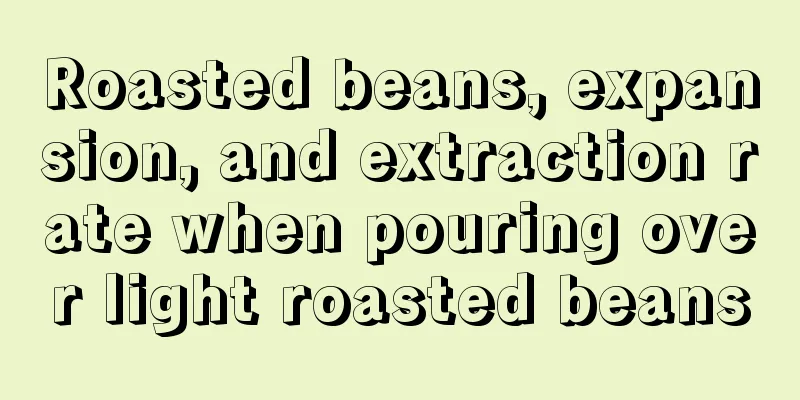Roasted beans, expansion, and extraction rate when pouring over light roasted beans

|
Hand-brewed coffee can retain the original aroma and flavor of coffee to a greater extent, and it has a strong sense of ritual and is very playable, so it has always been highly praised by practitioners and coffee lovers. Many friends will ask about the issues of roasted beans and expansion degree, as well as the extraction rate when hand-brewed lightly roasted beans. Today, the editor will share with you the issues of roasted beans and expansion degree, as well as the extraction rate when hand-brewed lightly roasted beans! I hope to bring you more fun in hand-brewed coffee. Light roasted coffee refers to the roasting degree from the first crack to the second crack in the roasting stage, that is, from cinnamon to city roasting. Generally, lightly roasted beans usually do not expand or bubble very well when exposed to hot water. This is not because they are not fresh, but because the texture of lightly roasted beans is relatively compact. Moreover, the beans used for light roasting are all high-grade fine beans, which are produced in high-altitude areas and have a relatively hard texture. Lightly roasted beans contain less carbon dioxide after grinding, and are not easy to absorb water and expand. They tend to sink during brewing, resulting in a thin surface. This situation will affect the flow rate, so it is usually recommended to use a high temperature of more than 90°C for lightly roasted beans and control the water column to be smaller, so that it is easier to brew out the flavor. Once again, the expansion and bubbling does not have a big impact on the flavor of coffee. In fact, it affects the extraction process more than the flavor, so don't worry too much about the size of the bubbles. Lightly roasted coffee has a more prominent sour taste because its coffee cell tissue has not yet fully expanded and the capillaries that assist in extracting coffee have not yet fully formed. If the usual extraction method is used, it may not fully reflect the good taste. Only by adding several changes to the basic extraction method can a better coffee with a better flavor be obtained. Light roasting is mainly for enjoying the various aromas contained in the coffee beans. In other words, it reduces the coffee aroma formed during deep roasting and highlights the characteristics of the beans. Therefore, the key to choosing light roasted coffee is the freshness of the beans and the rich aroma contained in the beans. Light to medium roasted coffee beans are relatively less bitter. Of course, bitterness is a relatively subjective sense, and there are still many customers who like strong bitterness. |
<<: After drinking coffee, how long does it take for caffeine to be metabolized in the body?
>>: We need to talk about whether pregnant women can drink coffee
Recommend
Why is there no coffee beans in the Nestle coffee ingredient list?
The secrets of Nestle coffee ingredients On the i...
5 basic factors that determine coffee quality
This article originally appeared in the April 2007...
A second-hand coffee machine shopping guide: exploring the city’s coffee passion and trading secrets
This article records the process of searching for...
How long can green coffee beans be stored?
Discover the nature of green coffee beans and the...
What animal feces do coffee beans smell like?
Coffee Bean Basics and Background Coffee beans ar...
Quick start guide to hand pouring: pay attention to these 3 details when making your first cup of hand pouring coffee
Source: Pacific Home Network In addition to the be...
Ketogenic black coffee, a new favorite for weight loss or a health hazard?
Ketogenic black coffee has become a new favorite ...
On the use of various "sugars" in baking
Various types of sugar are needed in baking, in ad...
Searching for the top, the top ten coffee beans rankings of 2020 are revealed
Recently, the top ten coffee beans rankings of St...
How many times can a bag of coffee beans be ground into coffee?
The influence of coffee bean type and quality on ...
How to choose the coffee bean roasting method that best suits your taste
Choose the coffee bean roasting method that best ...
Probiotic coffee, a wonderful fusion of coffee and probiotics
Probiotic coffee is a new type of drink that clev...
A Beginner's Guide to Coffee Bean Selection
A Beginner's Guide to Coffee Bean Selection C...
Coffee bean grinding and brewing tips revealed
This article introduces the techniques of grindin...
Coffee Bean Roasting Degree and Taste: How to Choose the Best Roasting Degree
1. Introduction Coffee is one of the most popular...









